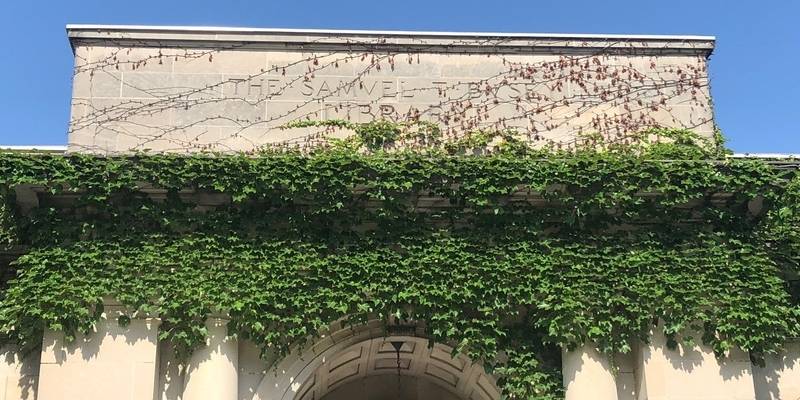The stateliness of the Urbana Free Library cannot be ignored. The stone structure, covered in ivy, standing in the heart of downtown Urbana — it just fits with the Urbana vibe. The Champaign Public Library is beautiful for sure, in all of it’s sleek modernity, but there’s something about the appearance of the UFL that gives me warm fuzzies. And yes, that’s an architectural term. The Samuel T. Busey Memorial Library, which is the part of the building that comprises the eastern portion of the library, before later expansions, is celebrating its 100th anniversary this weekend, and as indicated by the name alone it has roots that run deep in our community. The library is hosting a celebration on Saturday, and it has set up exhibits detailing the history of the building and the lives of Mary E. Busey and her husband Samuel.
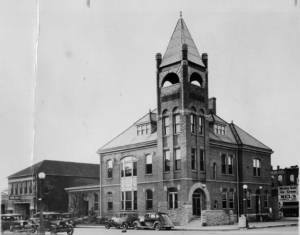 Before the Urbana Free Library was the Urbana Free Library, it was the Young Men’s Library Association, the The Urbana Library Association, and it was a subscription service. It was $25 to set up a subscription, and community members were welcome to take part, though $25 was not accessible to all members of the community. In 1874, the City of Urbana took over the library, which allowed it to be available to all free of charge. It moved locations several times, eventually settling in the city building for several years. It wasn’t always the most library-like atmosphere. According to Sherrie Bowser, archives librarian, “at one point the police station was also there, and the ‘bullpen’ (the name for jail holding cells in the 1800s) was under the library. People would complain about the drunks they could hear while in the library.” The library was also expanding, and at some point would need it’s own space.
Before the Urbana Free Library was the Urbana Free Library, it was the Young Men’s Library Association, the The Urbana Library Association, and it was a subscription service. It was $25 to set up a subscription, and community members were welcome to take part, though $25 was not accessible to all members of the community. In 1874, the City of Urbana took over the library, which allowed it to be available to all free of charge. It moved locations several times, eventually settling in the city building for several years. It wasn’t always the most library-like atmosphere. According to Sherrie Bowser, archives librarian, “at one point the police station was also there, and the ‘bullpen’ (the name for jail holding cells in the 1800s) was under the library. People would complain about the drunks they could hear while in the library.” The library was also expanding, and at some point would need it’s own space.
The city kept the library running through a mill tax, and continued to bank money for the possibility of a future building. By 1908, they were ready to consider a move. They originally floated the idea to Andrew Carnegie, and in an effort to raise money to make up the difference for what he was willing to finance, they set out to pass a bond. That local election was the first opportunity for women to vote on a public issue, and it passed. Carnegie saw the amount of money that Urbana now had for the project, and withdrew his funding, saying the city had too much of its own.
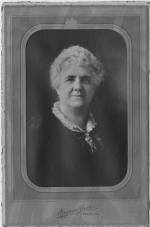 Enter the Busey Family. Isaac Busey and his nephew Matthew were two of the very first settlers in Champaign County, establishing a long history of Busey family prominence in the area. While attention is usually focused on men’s accomplishments during that time, this particular exhibit is different. It’s devoted to the generous contribution of Mary E. Busey, who stepped up when the library was looking for the remaining funding for the building and offered $35,000 from her husband Samuel T. Busey’s estate. Son of Matthew, a Civil War colonel and co-founder of Busey Bank, he’d passed away in a boating accident several years prior. “Mary was a figure in her own right,” says Bowser. “She was a member of over 20 clubs and organizations. She was a member the first year the University of Illinois Board of Trustees allowed women. She was a big supporter of women’s suffrage and very involved in the community.”
Enter the Busey Family. Isaac Busey and his nephew Matthew were two of the very first settlers in Champaign County, establishing a long history of Busey family prominence in the area. While attention is usually focused on men’s accomplishments during that time, this particular exhibit is different. It’s devoted to the generous contribution of Mary E. Busey, who stepped up when the library was looking for the remaining funding for the building and offered $35,000 from her husband Samuel T. Busey’s estate. Son of Matthew, a Civil War colonel and co-founder of Busey Bank, he’d passed away in a boating accident several years prior. “Mary was a figure in her own right,” says Bowser. “She was a member of over 20 clubs and organizations. She was a member the first year the University of Illinois Board of Trustees allowed women. She was a big supporter of women’s suffrage and very involved in the community.”
Mary brought with her not only the cash, but a connection with well-known local architect Joseph Royer, whose work can still be seen throughout Urbana: Urbana High School, Leal Elementary, The Lincoln Hotel, and the courthouse are just a few examples. They’d worked together previously together on both the hotel and the First Presbyterian Church.
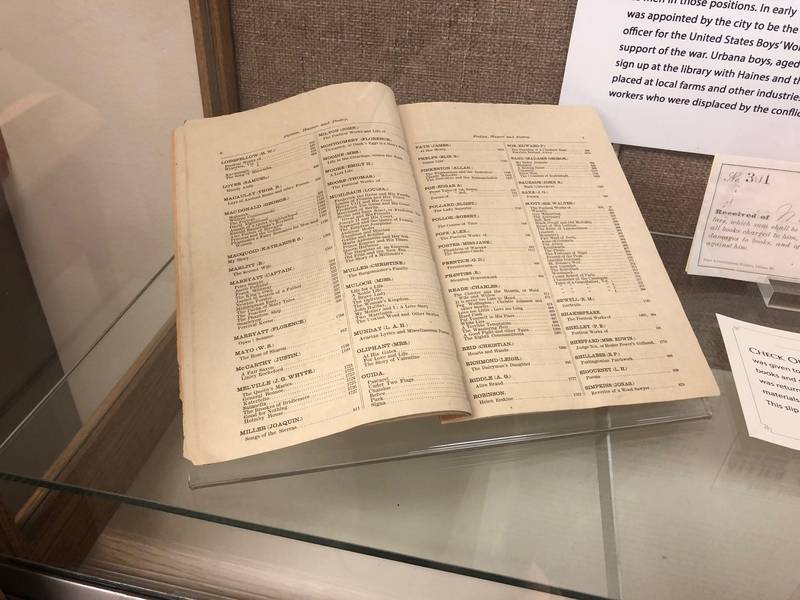
The exhibits detailing the history of the library are currently on display on the first and second floors of the Urbana Free Library. You can read more about the Buseys, Joseph Royer, longest serving librarian Ida B. Haines, and her cousin Minnie Jacques who was library treasurer for 50 years. You can also peruse artifacts from the early library days such as check out slips, the subscription book, and a book catalog, which patrons used to make their selections. Initially only librarians were allowed access to the books. The entire exhibit was researched by Thomas Kuiper, a practicum student from the iSchool.
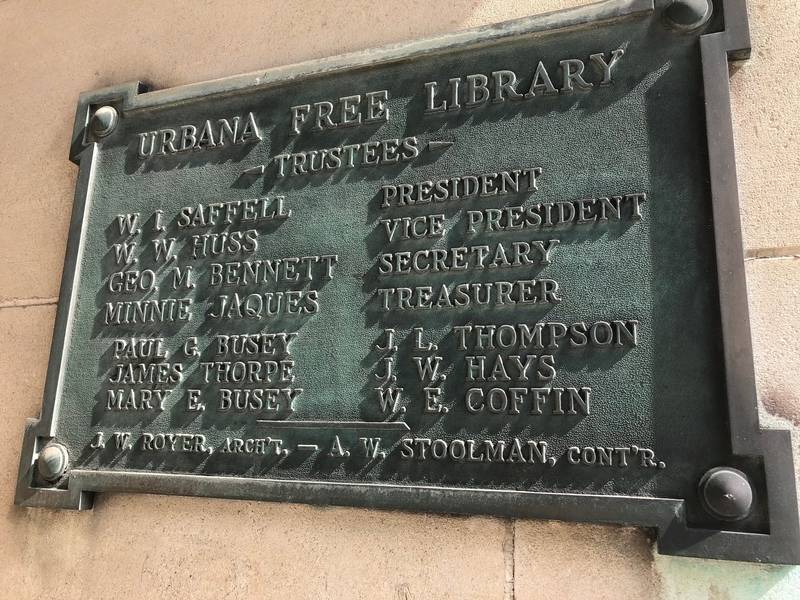
On Saturday, beginning at 1 p.m., the library will host a special event celebrating the 100th anniversary of the Samuel T. Busey Memorial Library. Royer’s original blueprints will be on display, there will be music from Carl Johnson and the New Orleans Jazz Machine, and there will be several speakers, including a proclamation from a member of the Urbana City Council. Brian Adams, a local author who wrote a book on the works of Joseph Royer, will be giving a talk on the building of the library. The event is open to kids as well, as there will be games from the early 1900s, with help from the Museum of the Grand Prairie. The cafe will have cake, and also some speciality drinks to reflect the era, such as a phosphate.
Here is the full schedule of the free event:
Special exhibits – “Mary E. Busey’s Gift:
A Centennial Celebration of The Samuel T. Busey Library”
McFarlane-Hood Reading Room; 1st and 2nd Floor Exhibit Cases
1:00 – 2:30 p.m. – Games and activities from the early 1900s
Co-sponsored by the Museum of the Grand Prairie. Lewis Auditorium
All ages welcome!
1:30 p.m. – Live music with the local Dixieland sextet
Carl Johnson and the New Orleans Jazz Machine
Busey Mills Reading Room
2:30 p.m. – Remarks by special guests
Busey Mills Reading Room
3:00 p.m. – Enjoy cake and specialty drinks from the Cafe (while supplies last)
Busey Mills Reading Room
3:30 – 4:30 p.m. – Presentation by author Brian Adams, “A Library Building Second to None: A History of Urbana’s Samuel T. Busey Library”
Lewis Auditorium
Historical photos provided by the Urbana Free Library. All others by Julie McClure.








